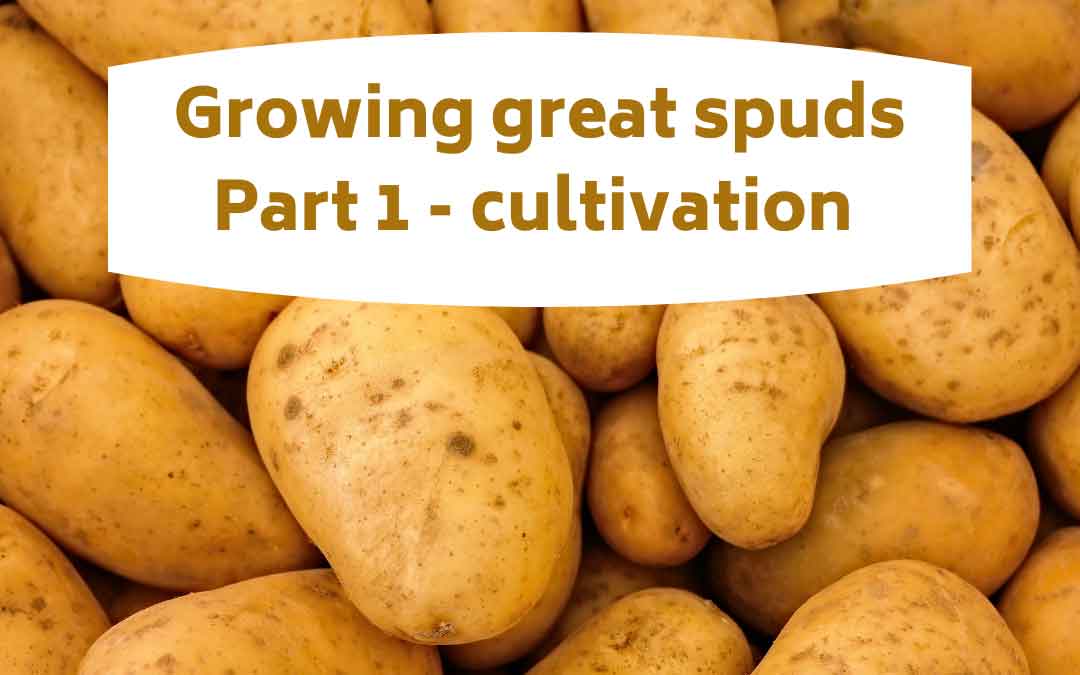Growing great spuds part 1 – cultivation

Top tips for growing potatoes in Melbourne
- Grow in rich soil in full sun
- Grow in well drained soil
- Leave potatoes beneath ground for good storage
- Start harvesting when plants flower
July and August are the perfect months to plant potatoes in our Melbourne climate.
Potatoes thrive in very rich, well-drained soil, in full sun. In these conditions, potatoes are easy and satisfying to grow. An advantage of growing your own is that you can harvest them as required, and avoid buying a bag from a greengrocer as I did recently, that turned out to be green and therefore inedible. I find store bought potatoes, even if stored in the dark, have a very short shelf life.
Make your own mix of compost and straw mixed with either well rotted cow manure or well rotted chicken manure plus a generous amount of blood and bone. Dig down about 15 – 20cm into your garden bed, creating a wide trench and hilling the soil up on either side for later backfilling. Lay a portion of your mix along the trench – about 2 bucketsful per square metre. Space potatoes 25 – 30cm apart and if planting several rows, these should be one metre apart. Backfill with soil to a depth of about 10cm, watering as you do so. Once the potatoes begin to shoot, backfill with another 10cm of soil and continue to do this when the shoots reappear until the trench is filled. If exposed to light, chlorophyll will develop which is accompanied by a toxin called ‘solanine’ that causes potatoes to turn green rendering them poisonous. Peeling the ‘green’ from the potatoes makes no difference to their toxicity.
It is important to plant certified seed potatoes as these will be disease and pest free. Buy them from your local nursery or Diggers Garden Club. Many spuds planted from those that have seeded in the pantry or been found to be green have a weak flavour so compost these and start with good seed stock for tasty and healthy results.
Seed potatoes are known as chats. Small chats – egg size – can be planted whole but larger ones can be cut into sections each containing an eye. If doing this, then allow the cut surface to dry out for a few days before planting. Also, knock off all but one shoot from each potato or section. Leave whole potatoes in the sun for a week before planting to harden them and to initiate shooting. At planting and flowering times, feed with a seaweed solution.
Potatoes come in determinate and indeterminate varieties just like tomatoes. Determinate potatoes grow beneath ground essentially at the depth they were planted and are deemed fast growers. They mature between 10-13 weeks. They do not need additional soil coverage but mulch them for weed suppression and to prevent potatoes being exposed to the sun. Indeterminate potatoes grow along the stem and need to be hilled up with soil to keep the potatoes from exposure to the sun and to cover surface roots. They are deemed slow growers and mature between 16-19 weeks.
Determinates include Kifler, Purple Congo, Pink Eye, Red Pontiac, Spunta, Russian Banana, Burgundy Blush, and Pentland Dell. Indeterminates include Brownell, Dutch Cream, Nicola, Sebago, Up to Date, King Edward, Salad Rose and Pink Fir Apple. All are available from Diggers. Some are available from Bulleen Art and Garden.
How do you know when to harvest your crop?
For new potatoes, harvest when flowering begins and the lower leaves are yellowing. For old potatoes, wait until the plant has died down. In both cases the best place to store the spuds is in the ground. For new potatoes feel down around the roots and remove the number you need for each feed; for old potatoes dig up one plant at a time.
If you do dig up more than you can use, do not wash the potato. Leave as much dirt on them as possible and store in a dark, cool, airy place.
Potatoes like a pH of 5.5-6 as do other members of their family such as tomatoes, capsicum and eggplant. Crop rotation is important so do not grow spuds where other family members have been growing and choose a new spot to grow them each year for a 4 year rotation. They are frost tender so should frost threaten, cover them with a cloth of any description the night before. If they are hit by frost, and you can hose the frost from them before the sun strikes the foliage (very early in the morning), they will survive.
If you lack garden space for potato growing, potato bags are available from nurseries or you could use a hessian sack. These can be placed on a balcony, a porch or anywhere in the garden. Adapt the soil mix described above (potting mix is not a suitable medium as it lacks sufficient nutrition). Adhere to the spacing guideline, which may mean as little as one seed potato per bag. This would however give a good return especially for a single person or couple and you could fill several bags with different varieties.
Written by Robin Gale-Baker.
